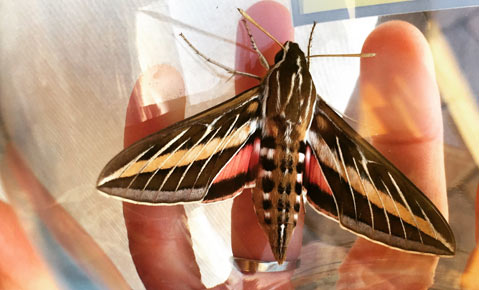
The winged beast snuck into our kitchen with a surprisingly loud flutter, like an errant hummingbird, and it took my wife a couple hurried shrieks to get it into a stemless wine glass. “Hurry,” she said. “It’s strong.” Once it was safely outside, the kids stared, like us, in amazement at these intricately detailed wings, set against a flash of bright pink. This was Hyles lineata, the white-lined sphinx or hummingbird moth, and it was the first I’d ever seen it up close in my 37 years.
“This species has boom years sometimes, especially in the deserts, where I’ve seen their caterpillars crossing the roads by the hundreds,” explained Mike Caterino, formerly the entomologist for the S.B. Museum of Natural History, now at Clemson University, “but it’s widespread and generally common any year.” Adults do visit flowers and hover to sip nectar with their long proboscis, hence the hummingbird moniker, but they’re strange for other reasons, too. “Most moths are strictly nocturnal, but Hyles doesn’t much care what time it is,” said Caterino. “They’ll fly during the day, at night, whenever it feels like it.”
And away it flew into the afternoon sun, fast and strong, though still moth-like and goofy.



